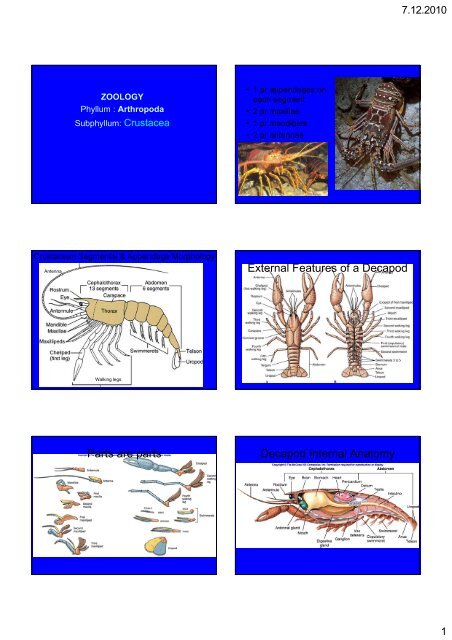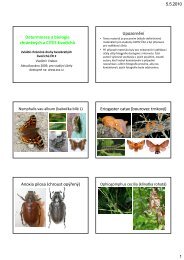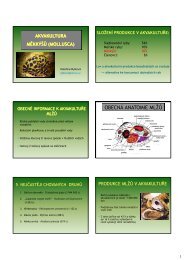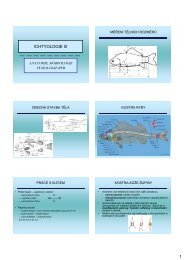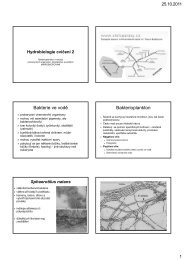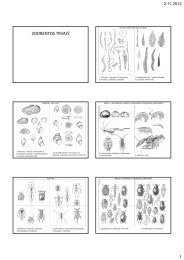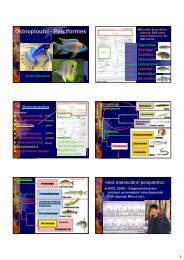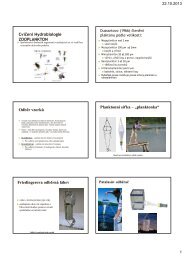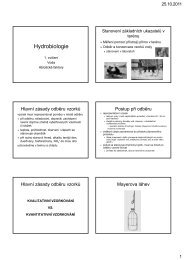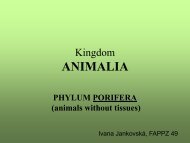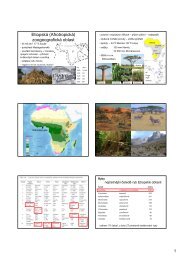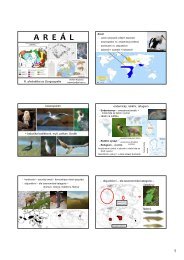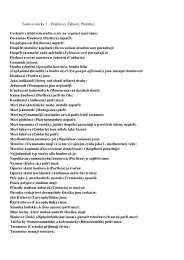Create successful ePaper yourself
Turn your PDF publications into a flip-book with our unique Google optimized e-Paper software.
7.12.2010<br />
ZOOLOGY<br />
Phyllum : Arthropoda<br />
Subphyllum: <strong>Crustacea</strong><br />
• 1 pr appendages on<br />
each segment<br />
• 2 pr maxillae<br />
• 1 pr mandibles<br />
• 2 pr antennae<br />
<strong>Crustacea</strong>n Segmental & Appendage Morphology<br />
Antenna<br />
External Features of a Decapod<br />
Walking legs<br />
Parts are parts<br />
Decapod Internal Anatomy<br />
1
7.12.2010<br />
Cuticle (Exoskeleton)<br />
Ecdysis (Molting)<br />
Molting in Decapods<br />
• Nervous system –ladder like<br />
• Modificatednefridia, nefrocytes<br />
• Colorless blood, open circulating system<br />
• Gill breathing<br />
• Gonochoristic<br />
• Sexual and Asexual reproduction<br />
• Indirect development<br />
Fairy shrimp (Anostraca)<br />
Kingdom (Regnum) : Animalia<br />
Phylum (Phyllum) : Arthropoda<br />
Subphylum (Subphyllum): <strong>Crustacea</strong><br />
Class (Classis): Anostraca<br />
Lateral compression of the body<br />
absence of carapax<br />
furca at tail is appendage shaped like a leaflet<br />
homonomous segmentation<br />
Multifunctional thoracic limb (locomotion, eating, sensory<br />
function, and breathing)<br />
Compoud eyes<br />
The females can produce eggs either in the usual way or<br />
via parthenogenesis.<br />
Freshwater or seawater<br />
2
7.12.2010<br />
Preserved specimen in collection<br />
Branchipus stagnalis<br />
Kingdom (Regnum) : Animalia<br />
Phylum (Phyllum) : Arthropoda<br />
Subphylum (Subphyllum): <strong>Crustacea</strong><br />
Class (Classis): Phyllopoda<br />
1. Order (Ordo): Notostraca<br />
Preserved specimen in collection<br />
Lepidurus apus<br />
simple carapax (two-piece shell)<br />
compound eyes<br />
leafy thoracic limbs<br />
bottom ends with Furka<br />
Kingdom (Regnum) : Animalia<br />
Phylum (Phyllum) :Arthropoda<br />
Subphylum (Subphyllum): <strong>Crustacea</strong><br />
Class (Classis): Phyllopoda<br />
3. Order (Ordo): Cladocera (water fleas)<br />
CLADOCERA<br />
Laterally flattened body in<br />
two-valved carapce<br />
Large black compound<br />
eyes<br />
1st pair of antennae with<br />
sensory functions<br />
(chemoreceptors)<br />
Strong second pair of<br />
two-part antennae is used<br />
for floatation in water<br />
Five pairs of thoracic limb<br />
gonochorism, sexual dimorfism,<br />
direct develpment<br />
Variation in parthenogeneis with<br />
sexual reproduction<br />
females in summer produce<br />
unfertilized eggs --> from which<br />
parthenogenetic females are<br />
hatched --> under stress factor are<br />
hatched males, which is followed by<br />
sexual reproduction --> the females<br />
produce efipium (drop-like<br />
formation containing 2 eggs<br />
passing the adverse conditions)<br />
filtering plankton, scraping attached<br />
algae, predators<br />
3
7.12.2010<br />
Preserved specimen in collection<br />
Daphnia pulex<br />
taxonomy<br />
predatory species<br />
Preserved specimen in collection<br />
Anomopoda<br />
(Chydoridae)<br />
(Bosminidae)<br />
Filtering species<br />
Ctenopoda<br />
Sididae<br />
Holopedidae<br />
(Daphniidae)<br />
(Daphnia sp.)<br />
(Ceriodaphnia sp.)<br />
(Macrothricidae)<br />
Anomopoda<br />
Chydoridae<br />
Bosminidae<br />
Daphniidae<br />
Moinidae<br />
Teardrop shaped body and large antennae<br />
Absence of carapax - sclerotization of body surface (CaCO3)<br />
Copepods have a compound, median single eye (2-3 ocelli), usually bright<br />
red and in the centre of the transparent head<br />
Kingdom (Regnum) : Animalia<br />
Phylum (Phyllum) : Arthropoda<br />
Subphylum (Subphyllum): <strong>Crustacea</strong><br />
Class (Classis): (Copepoda)<br />
The first pair of antenae are often long and conspicuous - floatation<br />
Swimming with the two-part thoracic appendages<br />
The abdomen is typically narrower than the thorax, and contains five<br />
segments without any appendages, except for some tail-like "rami" at the tip.<br />
Gonochorism, sexual dimorfism - females<br />
have at the abdomen sacs filled by eggs,<br />
in male antennae or the last pair of thoracic<br />
legs are transformed into an auxiliary<br />
coupulatory apparatus<br />
They have indirect development:<br />
the nauplius larva, metanauplius, kopepodit and the adult<br />
4
7.12.2010<br />
Preserved specimen in collection<br />
Cyclops strenuus<br />
Parasitic species<br />
Preserved specimen in collection<br />
Achtheres sp.<br />
Kingdom (Regnum) : Animalia<br />
Phylum (Phyllum) :Arthropoda<br />
Subphylum (Subphyllum): <strong>Crustacea</strong><br />
Class (Classis): (Branchiura)<br />
(Branchiura)<br />
Ectoparasites of fish<br />
Dorsoventrally flattened body<br />
Oval carapax<br />
4 pairs of twho-part thoratic appendages serving for<br />
movement<br />
Head appendages adapted for parasitism (attaching to<br />
the host - jaw transformed into suction disk, spike-like<br />
mandibles)<br />
Finny abdomen ends by furka<br />
Gonochorism with direct development<br />
Preserved specimen in collection<br />
(Argulus foliaceus)<br />
5
7.12.2010<br />
They are typically flattened dorso-ventrally<br />
Kingdom (Regnum) : Animalia<br />
Phylum (Phyllum) : Arthropoda<br />
Subphylum (Subphyllum): <strong>Crustacea</strong><br />
Class (Classis): (Malostraca)<br />
Order (Ordo): Isopods (Isopoda)<br />
Absence of carapax<br />
Compound sessile eyes<br />
Each segment bears a pair of "legs"<br />
Presence of leafy respiratory appendage at the abdomen<br />
• Suborder<br />
Asellota<br />
• The fusion of pleonites 5,<br />
4 and sometimes 3 to the<br />
pleotelson<br />
• Suborder<br />
(Oniscoidea)<br />
• Separated abdominal<br />
elements<br />
Isopoda<br />
Preserved specimen in collection<br />
Aselotta<br />
(Asellus aquaticus)<br />
pleotelson<br />
Oniscoidea<br />
(Oniscidae) - three-part end of antenna, narrow uropods<br />
Preserved specimen in collection<br />
(Oniscus asellus)<br />
(Porcellionidae<br />
Porcellionidae) – two-part end of antenna, narrow uropods<br />
(Armadillidiidae) - two-part end of antenna, wide uropods<br />
6
7.12.2010<br />
Preserved specimen in collection<br />
(Armadillidium vulgare)<br />
Kingdom (Regnum) : Animalia<br />
Phylum (Phyllum) :Arthropoda<br />
Subphylum (Subphyllum): <strong>Crustacea</strong><br />
Class (Classis): (Malostraca)<br />
Order (Ordo): (Amphipoda)<br />
<strong>Crustacea</strong>ns with no carapace and generally with laterally<br />
compressed bodies<br />
The head is fused to the thorax, and bears two pairs of<br />
antennae and one pair of sessile compound eyes<br />
The thorax and abdomen are usually quite distinct and bear<br />
different kinds of legs: the first of which are used as<br />
accessory mouthparts; the next four pairs are directed<br />
forwards, and the last three pairs are directed backwards.<br />
The abdomen is dividedid d into<br />
two parts: the pleosome which<br />
bears swimming legs; and<br />
the urosome, which comprises<br />
a telson and three pairs<br />
of uropods.<br />
Preserved specimen in collection<br />
(Gammarus fossarum)<br />
Five pairs of uniramous thoracic limbs - 1st pair ended with<br />
pincers, the other are for walking<br />
Thorax is covered by carapaxem<br />
Kingdom (Regnum) : Animalia<br />
Phylum (Phyllum) : Arthropoda<br />
Subphylum (Subphyllum): <strong>Crustacea</strong><br />
Class (Classis): (Malostraca)<br />
Order (Ordo): (Decapoda)<br />
Compound eyes on stalks<br />
Gills for breathing are located on the sides of the body<br />
The development of species living in waters of Czech<br />
Republic is direct<br />
Female is sticking eggs on lower part of abdomen, where<br />
small hatched crayfishes are developing<br />
7
7.12.2010<br />
taxons:<br />
1. garnats: garnáti a krevety<br />
2. crayfish: crawfish (claw), langouste (absence of<br />
claws, an extremely long antennae), lobsters<br />
(presnece of big claws)<br />
3. crabs<br />
Reptantia of Czech Republic<br />
INDIGENOUS SPECIES:<br />
(Astacus astacus) 15 - 25 cm, short, broad<br />
clows<br />
(Austropotamobius torrentium) 7-9 cm. broad<br />
clows<br />
INTRODUCED SPECIES:<br />
(Astacus leptodactylus) – up to 25 cm. long narrow clows<br />
Determination of species from CR<br />
Austropotamobius torrentium<br />
Astacus astacus Astacus leptodactylus Orconectes limosus<br />
(Orconectes limosus) – from North America. Marked red stains.<br />
(Pacifastacus leniusculus) – from North America.<br />
(Procambarus clarkii) - keept in aquaculture (USA) or as aquarium<br />
species<br />
Pacifastacus leniusculus<br />
Procambarus clarkii<br />
Astacus astacus<br />
8
7.12.2010<br />
Austropotamobius torrentinum<br />
Astacus leptodactylus<br />
Orconectes limosus<br />
Invasive species<br />
Homarus americanus<br />
Panulirus interruptus<br />
9
7.12.2010<br />
Crab development<br />
Eriocheir sinensis<br />
10


